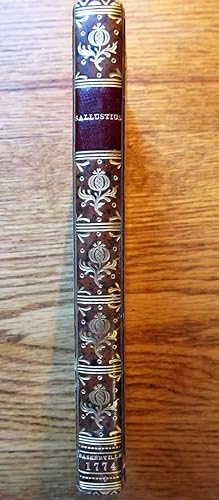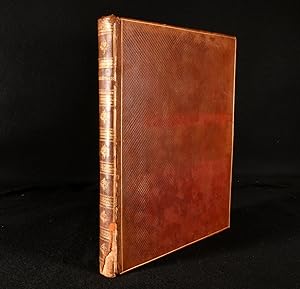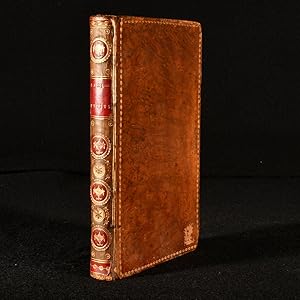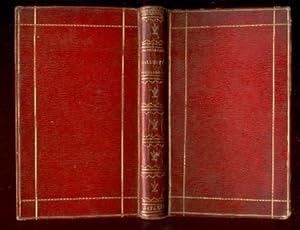Sallustius Crispus C L Annaeus Florus (8 results)
Product Type
- All Product Types
- Books (8)
- Magazines & Periodicals
- Comics
- Sheet Music
- Art, Prints & Posters
- Photographs
- Maps
-
Manuscripts &
Paper Collectibles
Condition
- All Conditions
- New
- Used
Binding
- All Bindings
- Hardcover (7)
- Softcover
Collectible Attributes
- First Edition (1)
- Signed
- Dust Jacket
- Seller-Supplied Images (5)
- Not Printed On Demand
Free Shipping
Seller Location
Seller Rating
-
C. Crispus Sallustius; et L. Annaeus Florus - Baskerville Imprint
Published by Johannis Baskerville, Birminghamiae, 1774
Seller: Novelty Shop Used & Rare Books, Novelty, OH, U.S.A.
Book
Full-Leather. Condition: Very Good. No Jacket. Bound in full leather, this is a beautiful little book. Marbled endpapers. Foreedges gilt. 275 pages. Please view photos to determine exact condition.
-
C. Crispus Sallustius; Et L. Annaeus Florus [Baskerville]
Published by Birminghamiae; Typis Johannis Baskerville. MDCCLXXXIV [John Baskerville. 1774], 1774
Seller: Riverby Books, Fredericksburg, VA, U.S.A.
Hardcover. Condition: Very Good. C. Crispus Sallustius; Et L. Annaeus Florus Birminghamiae; Typis Johannis Baskerville. MDCCLXXXIV [John Baskerville. 1774] Hardcover. Bound in full leather. Maroon leather binding (19th century), with raised cords, gold lettering and gold borders. Marbled endpapers. Foreedges gilt. Binding tight and attractive. 275 pages. Text block clean and tight. Pages square and free of foxing. Bookplate on the inside front cover with the name Benjamin T. Pierce. Text in Latin. Book measures 4.5 x 7 inches. A very small book from the Baskerville press a trend of the end of his printing career though Baskerville himself couldn t have known it yet (he died in 1775). I can find no later imprint from Baskerville s press until I can complete further research, I can speculate that this might have been the last work he printed.
-
C. Crispus Sallustius et L. Annaeus Florus.
Published by Birminghamiae: Typis Johannis Baskerville MDCCLXXIII. [John Baskerville. 1773], 1773
Seller: Riverby Books, Fredericksburg, VA, U.S.A.
Hardcover. Condition: Good. C. Crispus Sallustius et L. Annaeus Florus. Birminghamiae: Typis Johannis Baskerville MDCCLXXIII. [John Baskerville. 1773] Hardcover. Full leather. Brown leather with gold panels on the boards. Gold bands on the spine. Label in gold on black leather. Front cover detached (along with free endpaper and first blank), but present. Rear cover only barely attached. Marbled endpapers. Text block clean and tight. 317 pages. A few pencil notations in the text, dated 1845. With Baskerville s characteristic wide margins and or course printed in the types for which he is well known. Text in Latin. Rather more words to the page than in his great early editions of the Roman writers, but Sallust had a lot to say. Book measures 9.25 x 11.75 inches. There is little or no foxing. Pages are clean and bright and square. An example of Baskerville s work from the end of his career (though he didn t know it). He died in 1775.
-
[Histories]; Bellum Catilinarium; Bellum Jugurth; Historiarum Fragmenta; Oratioi Ad C. Caesarem; Epitome Rerum Romanarum
Published by Joannis Baskerville, Birminghamiae [Birmingham], 1773
Hardback. Condition: Good+. First Thus. [5], 2-317pp, [1]. Contemporary full straight grain morocco, raised bands, spine in six panels, author lettered directly to second panel with a small number of fleuron tools to foot, covers with single line border, single line to edges and inner edges, a.e.g., shell patterned marbled endpapers. Rubbed to outer joints and extremities, corners lightly bumped. Some light browning and occasional light foxing internally, but generally fairly bright and clean. Moss regarded this as "one of the most beautiful of Baskerville's editions, and by far, the most elegant one we have of this historian" (Moss, 'Manual of Classical Bibliography', Volume II, page 561). Gaskell 51; Harwood, pg 160, Moss II:561; Schweiger, page 883 Size: 4to.
-
C Crispus Sallustius et L Annaeus Florus
Published by Joannis Baskerville, Birmingham, 1773
First Edition
Leather. Condition: Good. None (illustrator). First edition. A smartly bound, first Baskerville edition of Sallust and Florus' historical writings. In a full diced calf binding.ESTC reference no T133320. Collated, complete.Armorial bookplate of Rev. Thomas Briggs of Kings College Cambridge to the front pastedown. Inscription to the recto of front endpaper 'Presented to John Quicke eldest son of John Quicke of Newton House in the county of Devon Esqre. on his leaving Eton, by his tutor the Reverend Thomas Briggs, 1799'.Baskerville was an innovative type designer and printer. His typefaces were greatly admired by Benjamin Franklin. The Baskerville type is regarded as a transitional serif typeface intended as a refinement of the old-style typefaces of the period such as Calson.This work contains historical writings by Sallust, an early Roman historian in the time of Julius Caesar, and Florus. Florus lived during the times of Hadrian and Trajan.In Latin.A lovely example of these classical historical writings, presented in the innovative Baskerville typeface. In a full diced calf binding. Externally, generally smart. Rubbed to the joints. Loss to the spine. Joints are cracked, with the front hinge tender. Bookplate to the front pastedown. Presentation inscription to the verso of front endpaper. Internally, firmly bound. Pages are bright. Spot to the first and last few pages. Otherwise, just the odd spots. Good. book.
-
Leather. Condition: Very Good Indeed. None (illustrator). An uncommon first octavo edition of John Baskerville's works of Sallust and Florus. From the library of the Crum Ewings and the Hamiltons of Lowood house. With the inscription of H Ewing to the recto of front endpaper.Baskerville was an innovative type designer and printer. His typefaces were greatly admired by Benjamin Franklin. The Baskerville type is regarded as a transitional serif typeface intended as a refinement of the old-style typefaces of the period such as Calson.This work contains historical writings by Sallust, an early Roman historian in the time of Julius Caesar, and Florus. Florus lived during the times of Hadrian and Trajan. In the original Latin.Preceding this octavo edition there was a quarto edition published in 1773.A lovely example of these classical historical writings, presented in the innovative Baskerville typeface. In a contemporary tree calf binding. Externally, very smart. Patches of light rubbing to the front board and spine. Small loss to the leather at the rear board. Former owner's inscription to the recto of front endpaper. Internally, firmly bound. Pages are very bright with just the odd spots to pages. Very Good Indeed. book.
-
C. Crispus Sallustius; Et. L. Anaeus Florus
Published by John Baskerville, Birmingham, 1773
Seller: B & L Rootenberg Rare Books, ABAA, Sherman Oaks, CA, U.S.A.
FIRST BASKERVILLE EDITION. Contemporary tree calf, rebacked. An excellent copy from the library of Edward Davenport with his armorial bookplate. First Baskerville edition of this excellent work. Baskerville (1706-1775) was the greatest printer of his era. He began experiments in letter founding and produced his amazing series of types now named after him. "The volume itself can be divided into two main parts. First, it contains Sallust's opus, which consists of the following works: two historical monographs, Bellum Catilinae (ca. 42/1 BC) and Bellum Iugurthinum (c. 41-40 BC); the extant fragments of Sallust's Histories, written in the conventional annalistic style and covering events from 78 BC onward; and a series of short works which have been wrongly ascribed to Sallust. They are two letters addressed to Caesar, Orationes ad C. Caesarem, de republica ordinanda and an invective against Cicero, C. Crispi Sallustii Declamatio in M. Tullium Ciceronem. It is very likely that both the letters and the invective were actually written after Sallust's death, possibly by rhetoricians writing during the early empire. Finally, the second part of the volume contains a summary of Roman history composed by Florus in the second century AD, Lucii Annaei Flori Epitome rerum romanarum (Lucius Annaeus Florus' abridgement of Roman history). Composed in a panegyric style, it covers 700 years, emphasizing the wars leading to the reign of Augustus, who is praised for being the emperor who finally brought peace to the Roman world. While in Baskerville's edition we find this historical summary divided into four books, the arrangement currently accepted by scholars is in two books, with the following generic title: Flori epitomae de Tito Livio bellorum omnium annorum DCC libri duo"(Pablo Alvarez, River Campus Libraries, University of Rochester). Sallust (86-35 BC) was a fourth-century writer, historian and politician. A Roman aristocrat, he was later a partisan of Julius Caesar. He is the earliest known Roman historian with surviving works to his name. Lucius Annaeus Florus (74-130 AD) was a Roman historian born in Africa, compiled his history of Rome that, despite a number of flaws in geographic and chronological detail, was used as a textbook into the nineteenth century.
-
Sallustius Bellum Catilinarium; Bellum Jugurthinum. Florus Epitome rerum Romanorum.
Published by Birmingham, John Baskerville, 1774. (In binding attributed to Roger Payne). Gaskell # 55., 1774
Seller: Peter Keisogloff Rare Books, Inc., Brecksville, OH, U.S.A.
Hardcover. Condition: Very Good. Gaskell # 55. 7 x 4 ¼ "; approx. page size: 16.9 x 10 mm. 274 pp. (p. 274 is mis-numbered 275). Smaller format edition of John Baskerville's Sallust which was first published & printed in Birmingham by English type founder & printer John Baskerville (1706-75) in quarto, 1773. Bookplate of William S. Stone (with printed designer's initials: E. C. [?] & 1884) on front marbled paper paste down. Ownership inscription (on first blank flyleaf): "T. Smith E[x] dono H. Seymour.-1819" (& some nearly erased penciling: Thomas Smith.) & from the back marbled endpaper blank side (in pencil): c. p. [collated perfect] 1865. It/F Ex don. H. V. F- (plus other number/price codes here & in front). An earlier dealer or collector has penciled on blank side of front marbled endpaper: "Baskerville edition Roger Payne Binding". In a binding attributed to English bookbinder Roger Payne (1738-97). Bound in full dark red straight-grain morocco; front & back covers gilt ruled in plain & chain lines to form a simple intersecting rectangular border of ½ " width around edges of covers; plain line running the length of the edges & repeated on the turn-in. Spine in 6 compartments featuring gilt title: "Sallustius", in small capitals & at base of spine: "Baskerv." in slightly larger capitals. The spine also uses a series of plain & scalloped lines & a series of small five-pointed stars & 5 small gilt urns in the center of each compartment. All edges gilt, sewn headbands & dark blue silk place-marker. Edges of pages show age tanning, a few small occasional spots. Top & base of spine are rubbed, slight rubbing to spine edges, & cover edges; small blemish (rubbing) to one of the spine compartments; lower front right corner has the leather worn away & other corners show minor wear. Overall, a fairly well-preserved copy & binding. Although, as far as we know, an uncatalogued binding, possibly by Payne. It could be his work; as the binding features several characteristics mentioned by Sarah T. Prideaux in her "Bookbinders and Their Craft" (1903; pp.43-45), including the tight back (from using an inner russia leather lining on the spine), the use of straight-grain morocco & the simple, elegant tooling that is associated with some of his known work. "Somehow the light and graceful character of his work seems especially suitable to the straight-grain morocco then in fashion. [.] Payne wisely adhered to the style that he practically invented. There is not perhaps very much scope in his designs, and yet the variation is considerable considering the few tools he employed. These he used in fresh combinations with great inventiveness and unfailing taste, getting much richness of effect by the simple device of dots. In fact, he thoroughly understood the art of getting effect by simplicity rather than by elaboration of ornament." (Prideaux, p.44-45).




![Seller image for [Histories]; Bellum Catilinarium; Bellum Jugurth; Historiarum Fragmenta; Oratioi Ad C. Caesarem; Epitome Rerum Romanarum for sale by Zetetic Books](https://pictures.abebooks.com/inventory/md/md31787656029.jpg)


